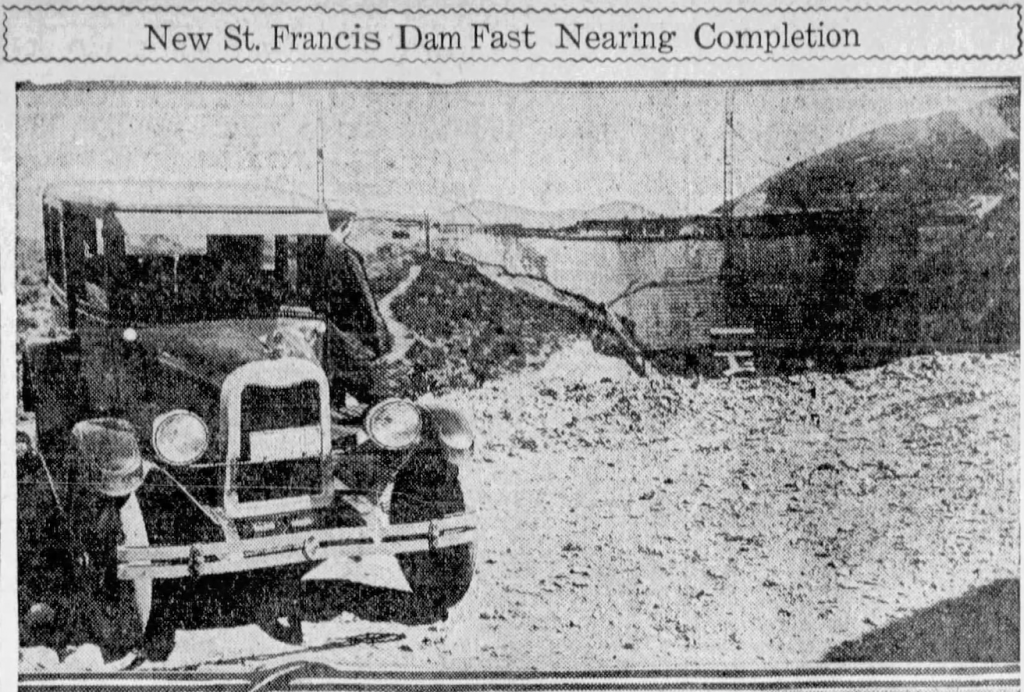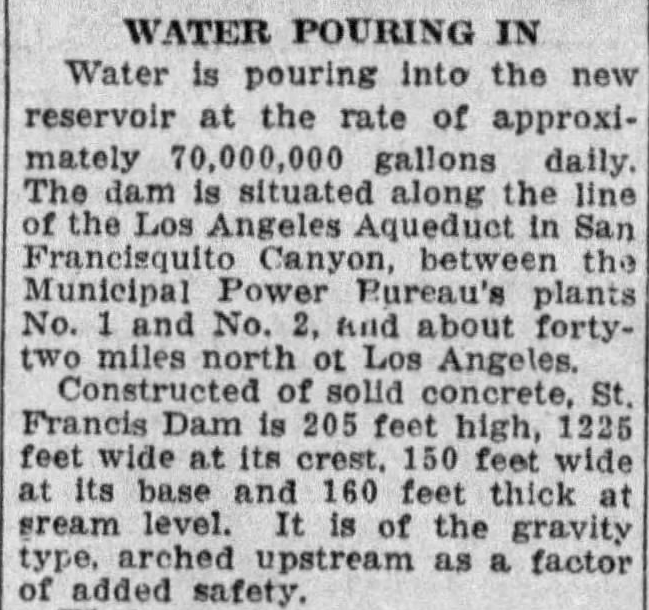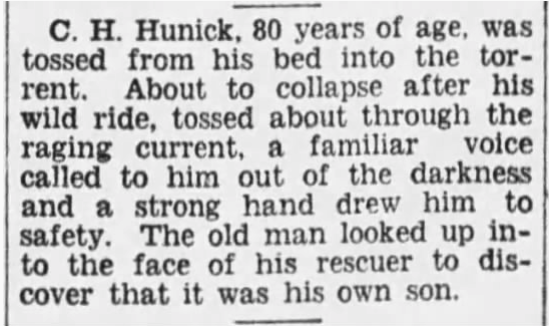On March 12, 1928, the St. Francis Dam in San Francisquito Canyon, northwest of Los Angeles, California, collapsed. A torrent of water rushed downstream, killing nearly 500 people and sweeping away thousands of acres of fertile land. The catastrophic failure is considered one of the worst civil engineering failures in the United States. The disaster resulted in updated dam safety legislation to prevent a similar incident from ever occurring again.
In the early 1900s, Los Angeles was experiencing dramatic growth, and William Mulholland, the general manager and chief engineer of the Los Angeles Bureau of Water Works and Supply, wanted to build a dam to regulate water storage. The dam was integral to the Los Angeles Aqueduct system and would create a lake containing 12 billion gallons of water.
Planning began, and by 1925, construction was underway in earnest. On two separate occasions, the dam’s height increased by 10 feet to provide more water storage. However, engineers made no modifications at the base. There were also unmitigated geologic hazards like ground instability and canyon rock, later deemed unsuitable.
The dam was completed in 1926, and the lake began to fill. It took two years for the dam to reach capacity, which it did on March 7, 1928.
On March 12, 1928, about 11 hours before the disaster, Tony Harshelfeger, who lived below the dam, notified Mulholland that muddy water was leaking from the dam’s side. Mulholland and the assistant chief engineer drove to the dam and proclaimed it safe. Shortly before midnight, the concrete walls of the dam collapsed. Survivors recalled hearing a sound like thunder. A 125-foot-high wall of water careened down the canyon, destroying everything in its path and scouring the canyon walls as it raced toward the Pacific. Nearly 24,000 acres of prime land washed away, devastating the local farming industry for years. Harshelfeger, who initially alerted authorities to the leak, drowned.
In the days following the disaster, stories of loss and survival began to emerge. C.H. Hunick, 80, was tossed from his bed as water crashed into his house. He rode the raging current and was close to death when a strong hand reached out and grabbed him. Hunick looked up to discover that the rescuer was his son.
When the wall of water hit the Holsclaw home, it was lifted from its foundation and carried for some distance. The parents survived by clinging to floating debris and trees, but their 12-year-old daughter and baby died.
Thelma McCauley, 16, was sick with measles when flood waters hit her home. The current swept her nine miles downstream, and she spent 12 hours in the water. Rescuers discovered her alive the next day, but she lost her parents and brother.
The death toll from the St. Francis Dam tragedy was estimated at close to 500 but was possibly much higher. Some bodies were never recovered, having been buried deep in silt or washed out to sea. The canyon was also home to many migrant workers whose identities were not known.
Following the disaster, a devastated Mulholland took full responsibility for the failed dam. With his professional career in shambles, he retired months later. Experts conducted hearings, coroner’s inquests, and studies to prevent another tragedy. Lawmakers passed legislation to increase dam safety, and Los Angeles paid more than $7 million in restitution to the victims’ families and affected landowners.
If you would like to learn more about the St. Francis Dam tragedy, search Newspapers.com™ today.






That was a very interesting story. I enjoyed reading it very much. I look forward to reading more of the historical news.
There is a paperback book series called Images of America put out by Arcadia Publishing Company all written by independent people covering all sorts of historical aspects of local American history. The books are well bound and use good quality photographic-like paper. If purchased from the publisher the cost generally runs around $20. But you can often find them on eBay for less. A couple of other sources are Thrift Books and Second Sale. I buy many books from them as their prices can’t be beat and shipping is often free or minimal and they are very reliable. One of these that I have purchased deals with the St. Francis Dam disaster. These books consist of photographs that are captioned in such a way as to show the chronological order of events concerning the subject with no long tedious chapters to read. Also, you might want to view the movie “Chinatown” with Jack Nicholson. It’s a well-done period film with an interesting story thread about the Southern California water wars of that period and the dam collapse. Hope you find this information helpful.
Chinatown was loosely inspired by Mulholland’s project to bring water to Los Angeles, but it flipped the story. It had water being taken from the San Fernando Valley and dumped into the ocean instead of water being taken from the Owens Valley to irrigate the San Fernando Valley.
Yes, that was a major flaw. The Owens Valley has recovered some but the devastation was so severe it will likely never recover to its former beauty.
The problem with Chinatown is…they purposefully got facts wrong & smeared the families in- volved…a) painting Mulholland as a land-grabbing uncaring megalomanic–when in truth he was the opposite in life, a loving, giving, caring person of deep sensitivities, & only owned a lot of land as it was pennies/acre & everyone was buying it up to have farms–he had a 700 acre avacado ranch. And b) they also painted his relatives (the Ijams clan) as dirt-poor, uneducated folk, when in reality they were super-smart, hard-working, successful people who owned a lot of land in the San Fernando Valley (having arrived in 1885, so again land was cheap & large amounts able to be purchased), as well as still today owning Union Island in the Sacramento River delta.
Well, Chinatown was a “representation” of the rape of Owens valley and other places to steal water to create San Fernando Valley, etc. But to get a truthful representation of Mulholland and his instigations, one should read the truthful and insightful “Cadillac Desert” which did correctly portray Mulholland and his efforts that were horrific.
I would like to sign up with Newspapers .com in order to peruse obituaries etc. for my Ancestry.ca tree (22,000 souls and growing since 2006); but upon giving it a try I discovered it to be too expensive in addition to my Ancestry World Delux Membership.
Me too!
Well, that answers my question and says that I can’t afford it either. I’m sure its a good source of information. Too bad.. But us Social Security people are always precluded from things like this.
A 6-month Everything above, plus Fold3® and Newspapers.com™ commitment of $259 saves you $100 when compared to a 1-month commitment of $59.99 over the same time period.
https://blog.newspapers.com/march-12-1928-st-francis-dam-disaster/?_gl=1*1xf12g7*_ga*MTg5OTA1MTczNy4xNjYzMDU3OTQ5*_ga_4QT8FMEX30*MTY3ODA3NzI4MS4xNDIuMS4xNjc4MDc3MzAyLjM5LjAuMA..
The point is many fine people cannot afford that. That is a huge price for digital information. It isn’t like you have to reprint anything.
You can usually access genealogy subscriptions for free if you have a library card. Many libraries have subscriptions to things like newspapers.com that give their patrons access. I suggest you check with your local library.
I have the highest membership on Ancestry and I’m pretty sure it includes the newspaper and 3Fold websites. Just sign in with your Ancestry id.
Not true. Newspapers.com is a separate login and membership.
Newspapers.com is now a separate login and membership. I’ve been a member of Ancestry.com since 1998 for the USA, and I thought that at one time newspaper articles were included in the subscription. I am now paying a 6-month fee for access to newspapers.
I, too have the highest level of Ancestry membership. It does include a version of Newspapers.com, however, it is the entry level version. There are many things I cannot access at this level of membership and I refuse to pay for a separate subscription for obituaries when my library card gives me access for free.
Libraries sometimes subscribe to Newspapers.com, as well as Genealogical Societies. If you have one near you, you can do this research on their computers.
Yes, the two subs are pricey. Over $400 a year for both. I am using them both a lot, so for now, worth it. But it is a little painful.
Check with your public library. Many have. Subscriptions that are available to card holders.
The South Fork Dam failed on Friday, May 31, 1889, and unleashed 20,000,000 tons of water that devastated Johnstown, PA. The flood killed 2,209 people, the loss of 1,600 homes, and over $17,000,000 in property damage. Human error was also a factor in this tragedy as warnings were ignored.
This is the one I remembered hearing about recently. Wasn’t there some kind of responsibility ties to either Rockefeller or Ford? That also sticks in my mind.
Yes, I think it was Henry K Frick and Carnegie, and Andrew Mellon as well. It was the industrial age, and they were all riding high. Here’s a link: https://www.history.com/news/how-americas-most-powerful-men-caused-americas-deadliest-flood
Thank you for remembering and mentioning it here. Not that this story isn’t bad enough but claiming the worst of something should always come with the story teller having done their due diligence for accuracy out a more appropriate title. A lot of people lost their lives and livelyhoods to permit an oversight like this to go in mentioned. A 5 second search on the interwebs would have gotten the author several damn engineering failures worse by fatality and/or damage cost that definitely earn the title of “Worst”.
Yes. That is what I thought also.
My grandmother was a survivor of the 1889 Johnstown flood. She was hanging on to a roof & sailed into the next county ,grabbed a tree limb & stayed in a tree overnite tiil rescued the nextt day. Her mom 3 sisters & 1 brother died. Her dad & 2 brothers survived. She was 14. Hunan error for sure caused the flood.
That was such a tragedy. Here’s a link to a blog we wrote a couple of years ago about the Johnstown Flood: https://blog.newspapers.com/the-johnstown-flood-of-1889-may-31-1889/
I also find it too expensive, combined with my Ancestry.com world membership,
I highlighted this event in when it was documented on a corrido or lyrical ballad sung in Spanish. Come by and have a look and listen to it! Bilingual downloadable lyric sheets are available. Thank you..
Sounds good, en Castellano también!
Not enouĝh AUSTRALIAN and UK content….
I have this Newspaper subscription through Ancestry. The problem I have is that the way you research a name (even with a date) I get LOTS of things that are not relevant. I feel like the search capabilities should be easier and more direct to the information requested. In this day and age it seems there should be a way to narrow the search. I have been considering cancelling my subscription because of this issue. Also, I believe this flood story is the one that my father was involved in. He and fellow workers were living down from the dam face and the only thing that save him is that he was so skinny he went up through the stove pipe hole in the tent. My mother told me that he woke up a lot over the years, sweating and with terrible dreams.
I found the same thing, too, Linda. When looking for very specific names and locations on Newspaper, I get all kinds of people with different names, and in different states and cities. I can’t ever find an actual reference to my ancestors I’ve typed in. I’ve tried with several names and locations…nothing.
Hi Linda, One of my favorite tips is to use quotation marks around the name or keyword you are searching. For example, if I’m searching for James Miller, I will search “James Miller” in quotes, then the search engines will only return results where those two names appear together. It is a great way to filter down results. Also, use other filters (date, location, etc.) to further narrow your results. Try all variations of names also – like “James M. Miller,” or “J.M. Miller,” or “Jas. Miller” until you see how your ancestor was referred to in the paper. Hope these tips help.
Thank you for this tip!
Great comment! Remember that “,” action also works in other search engines such as Google and for searching for just about anything, not just names. Also, a + sign will include results with the combination such as “Janet Doe” + graduation will include results for Janet with results that also contain the word graduation. Opposite: A – (minus) sign can exclude results such as:
“Janet Doe – “Jeremy Doe” Janet and Jeremy might be a different family than what you are searching but come up often, cluttering the results. A * symbol replaces missing letters and comes in handy when there might be multiple spellings of a search term such as a name like Katie: Kat* will result in hits for katie, katey, kati, Kate Katherine! And so on… There and many more search functions that can better define your search in many circumstances. Search for these search engine shortcuts online!
Happy searching!
Try narrowing your search to years (1903 – 1937) and pick a state, also put words in quotations so it will search for an exact match, Linda Kriss will search all Linda and Kriss, but if you put “Linda Kriss” it will only search for the two words together.
Newspapers is just one resource. I agree with those comments above; data that you have to sift through or know the names of local publications that may have been around in the mid 1800’s-1900’s. Thanks to the person that mentioned the Library as a source for the Newspapers.com Subscription availability.
I used to drive through San Francisquito Canyon every week. You can still see the remains of the dam and there is a historical marker and information marking the spot.
Lots of interesting things to be found in Newspapers … though in my mind, the levee failures in New Orleans must rank up there with the worst.
Worst Civil Engineering Failure in US History? Not to downplay the seriousness of the event, but what about the Johnstown dam failure in 1889 that took the lives of over 2000 people?
I’m a civil engineer and I shudder everytime I read about one of these events. Especially when Mulholland was notified of a leak, then he and the assistant chief engineer drove to the dam and proclaimed it safe. That was 11 hours before the disaster.
One other resource for newspapers is State Universities. “The Portal for Texas History” is a resource for digitized Texas newspapers that have been archived by university systems and access to these gems is free! I know Georgia has a version of this and believe Louisiana does, too. I even found a resource like this in Lunenburg, Nova Scotia through a local town library. When I researched my husband’s family this way I found information about his relatives in the “Boerne Star” a small Texas Hill Country publication. Check to see if your state or province offers this service. Great resource!
Teton dam break 1976
Has PBS ever done a documentary on this? It sounds like American Experience would be the right people to tell it.
Yes. American Experience: Flood in the Desert
I find it interesting that the one street name in a high end area is Mulholland. Why would they want to give a street his name after that disaster?
They named the street three years before the disaster.
The dam was a Huge tragedy, however a later panel of worldwide engineering experts concluded that when it was built with the knowledge & tools of that era, there was no way to know it had been built on shifting sandy soil that would cause this disaster. They absolved William Mulholland of all responsibility of this due it was impossible to know of the situation in his time. He lost his own best friend in the dam disaster and himself died with a broken heart and spirit.
It wasn’t sandy soil; that would have been an obvious error. In fact, the west side had been built on ground deposited in the past by a landslide.
Agreed, my mistake in mis-recalling the particular of the exact cause–my point though, was, the modern engineers Absolved Mulholland, due, as I stated, there was no way in that era w/ the knowledge & tools of the time to know the dam would fail.
Exactly. Have you read the book Rivers in the Desert? https://www.goodreads.com/en/book/show/22878705
No, still on my reading list : )
I was working as a Pacific Bell telephone operator in the early 1960’s (1963 maybe) when there was another dam failure. I see to remember it was in the San Gabriel Mts. Huge disaster.
The Baldwin Hills Dam disaster occurred on December 14, 1963. It began with signs of lining failure, followed by increasingly serious leakage through the dam. After three hours the dam breached, releasing 250 million gallons of water, resulting in five deaths and the destruction of 277 homes. Vigorous rescue efforts averted a greater loss of life.
MORE: https://www.lafra.org/lafd-history-los-angeles-dam-failures/
“The catastrophic failure is considered one of the worst civil engineering failures in the United States.” – please note is says “one of the worst” not “the worst”. Also for those talking about 1976 – please note this event happened in 1928. Before making disparaging remarks double check what the original story stated.
No one commented about my first car, shown here, the 1928 Chev coop. Got it about 1946 at age 15. Some one had put yellow spoke wheels. Not fast, but reliable, with a crank.